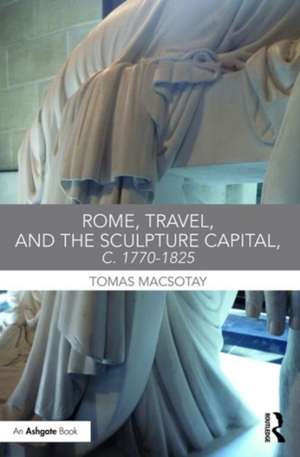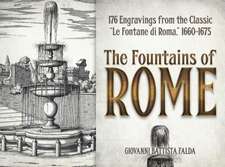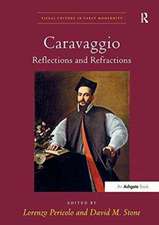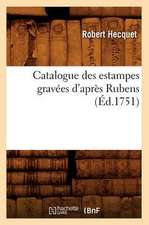Rome, Travel and the Sculpture Capital, c.1770–1825
Editat de Tomas Macsotayen Limba Engleză Hardback – 24 aug 2016
Rome, Travel and the Sculpture Capital, c.1770–1825 is the first study to piece together the labyrinthine sculptors' world of Rome between 1770 and 1825. The volume sheds new light on the links connecting Neo-classicism, sculpture collecting, Enlightenment aesthetics, studio culture, and queer studies. The collection offers ideal introductory reading on sculpture and Rome around 1800, but its combination of provocative perspectives is sure to appeal to a readership interested in understanding a modernized Europe's overwhelmingly transnational desire for Neo-classical, Roman sculpture.
Preț: 852.22 lei
Preț vechi: 1218.47 lei
-30% Nou
Puncte Express: 1278
Preț estimativ în valută:
163.08€ • 174.38$ • 135.97£
163.08€ • 174.38$ • 135.97£
Carte tipărită la comandă
Livrare economică 18 aprilie-02 mai
Preluare comenzi: 021 569.72.76
Specificații
ISBN-13: 9781472420350
ISBN-10: 1472420357
Pagini: 294
Dimensiuni: 156 x 234 x 21 mm
Greutate: 0.7 kg
Ediția:1
Editura: Taylor & Francis
Colecția Routledge
Locul publicării:Oxford, United Kingdom
ISBN-10: 1472420357
Pagini: 294
Dimensiuni: 156 x 234 x 21 mm
Greutate: 0.7 kg
Ediția:1
Editura: Taylor & Francis
Colecția Routledge
Locul publicării:Oxford, United Kingdom
Cuprins
Contents:
List of Illustrations
List of Contributors
Acknowledgments
Introduction: ‘Close up and Far Away’
Tomas Macsotay
Part I
A Space for Encounters
1 Restoring and Making Sculpture in Eighteenth-Century Rome: A Shared Practice
Chiara Piva
2 Promoting Sculpture in Eighteenth-Century Rome: Exhibitions, Art Criticism, Public
Susanne Adina Meyer
3 Bringing Modern Rome to Chatsworth: The Formation of the 6th Duke of Devonshire’s Sculpture Collection
Alison Yarrington
Part II
Close to Canova
4 Truly Transnational? Sculpture Studios in Rome after the Restoration
Christina Ferando
5 In the Shadow of the Star: Career Strategies of Sculptors in Rome in the Age of Canova (c.1780–1820)
Daniella Gallo
6 Canova and his German Friends
Johannes Myssok
Part III
Distance and Difference
7 Multiple Views, Contours and Sculptural Narration: Aesthetic Notions of Neoclassical Sculpture in and out of Rome
Roland Kanz
8 Sculptor and Tourist: John Flaxman and His Italian Journals and Sketchbooks (1787–1794)
Eckart Marchand
9 Struggle and the Memorial Relief: John Deare’s Caesar Invading Britain
Tomas Macsotay
10 The Sculptor, the Duke, and Queer Art Patronage: John Gibson’s Mars Restrained by Cupid and Winckelmannian Aesthetics
Roberto C. Ferrari
Bibliography
Index
List of Illustrations
List of Contributors
Acknowledgments
Introduction: ‘Close up and Far Away’
Tomas Macsotay
Part I
A Space for Encounters
1 Restoring and Making Sculpture in Eighteenth-Century Rome: A Shared Practice
Chiara Piva
2 Promoting Sculpture in Eighteenth-Century Rome: Exhibitions, Art Criticism, Public
Susanne Adina Meyer
3 Bringing Modern Rome to Chatsworth: The Formation of the 6th Duke of Devonshire’s Sculpture Collection
Alison Yarrington
Part II
Close to Canova
4 Truly Transnational? Sculpture Studios in Rome after the Restoration
Christina Ferando
5 In the Shadow of the Star: Career Strategies of Sculptors in Rome in the Age of Canova (c.1780–1820)
Daniella Gallo
6 Canova and his German Friends
Johannes Myssok
Part III
Distance and Difference
7 Multiple Views, Contours and Sculptural Narration: Aesthetic Notions of Neoclassical Sculpture in and out of Rome
Roland Kanz
8 Sculptor and Tourist: John Flaxman and His Italian Journals and Sketchbooks (1787–1794)
Eckart Marchand
9 Struggle and the Memorial Relief: John Deare’s Caesar Invading Britain
Tomas Macsotay
10 The Sculptor, the Duke, and Queer Art Patronage: John Gibson’s Mars Restrained by Cupid and Winckelmannian Aesthetics
Roberto C. Ferrari
Bibliography
Index
Notă biografică
Tomas Macsotay is a Ramón y Cajal Research Fellow at the Universitat Pompeu Fabra, Barcelona. He is the author of The Profession of Sculpture in the Paris Académie (2014) and the co-editor of Morceaux. Die bildhauerischen Aufnahmestücke europäischer Kunstakademien im 18. und 19. Jahrhundert (2016).
Recenzii
‘Rome, Travel and the Sculpture Capital, c. 1770–1825 offers a fresh approach to the study of patrons, artists and markets for Roman sculpture in the late eighteenth and early nineteenth centuries. Instead of focusing on the agency of the traditional cast of powerful tastemakers and artists, such as Antonio Canova, Bertel Thorvaldsen and Johann Winckelmann, the volume emphasizes the shifting status of travellers, trade routes, political systems and institutions that underpinned the production, consumption and reception of marble sculpture in Rome. The book thus points to areas of contingency and flux that have been otherwise obscured by the unquestionably canonical status of Rome as a "sculpture capital" during the period. […] Rome, Travel, and the Sculpture Capital, c. 1770–1825 helps to advance and complicate our understanding of Rome’s reputation as a center of neoclassical art and grand tourism that has long been enshrined in studies related to the history of sculpture. Its focus on complex systems and networks of artists, patrons and other local conditions provides an exciting path for future directions in the study of Roman sculpture.’ Katie Hornstein, review in Sculpture Journal (27.3, 2018, pp. 377–79)
‘This important collection of essays by an international team of scholars sheds new light on Rome’s emergence as an international center of sculptural production and consumption at the period spanning the end of the eighteenth-century through the defeat of Napoleon. Their research takes us inside the studios of artistic giants like Canova and Thorvaldsen as well as a host of lesser-known figures who made Rome Europe’s sculpture capital par excellence. Together, the authors reveal the Eternal City as a cosmopolitan community of patrons and practitioners whose interactions led to technical breakthroughs, stylistic innovations, and lofty claims for the centrality of sculpture to modern life.’ Jeffrey Collins, Bard Graduate Center, USA ‘Comprised of archivally rich analyses, this volume traces the myriad forces that ensured Rome's ascendance as the capital of European sculpture in the late-eighteenth and early-nineteenth centuries. Essays chart an expanded topography of sculptural networks, drawing together luminaries like Canova, Cavaceppi, and Flaxman; the specialized tradesmen and assistants whose work was integral to the business of sculpture; and aesthetic interlocutors in the guise of patrons, scholars, and museum personnel. Bringing new life to the material and theoretical lives of sculpture, its makers and audiences, the volume significantly expands our appreciation of the interlinked histories of sculptural restoration, production, and consumption that underwrote a Roman dialectic of ancient and modern.’ Sarah Betzer, University of Virginia, USA
‘This important collection of essays by an international team of scholars sheds new light on Rome’s emergence as an international center of sculptural production and consumption at the period spanning the end of the eighteenth-century through the defeat of Napoleon. Their research takes us inside the studios of artistic giants like Canova and Thorvaldsen as well as a host of lesser-known figures who made Rome Europe’s sculpture capital par excellence. Together, the authors reveal the Eternal City as a cosmopolitan community of patrons and practitioners whose interactions led to technical breakthroughs, stylistic innovations, and lofty claims for the centrality of sculpture to modern life.’ Jeffrey Collins, Bard Graduate Center, USA ‘Comprised of archivally rich analyses, this volume traces the myriad forces that ensured Rome's ascendance as the capital of European sculpture in the late-eighteenth and early-nineteenth centuries. Essays chart an expanded topography of sculptural networks, drawing together luminaries like Canova, Cavaceppi, and Flaxman; the specialized tradesmen and assistants whose work was integral to the business of sculpture; and aesthetic interlocutors in the guise of patrons, scholars, and museum personnel. Bringing new life to the material and theoretical lives of sculpture, its makers and audiences, the volume significantly expands our appreciation of the interlinked histories of sculptural restoration, production, and consumption that underwrote a Roman dialectic of ancient and modern.’ Sarah Betzer, University of Virginia, USA
Descriere
Rome, Travel and the Sculpture Capital, c.1770–1825 is the first study to piece together the labyrinthine sculptors' world of Rome between 1770 and 1825. The volume sheds new light on the links connecting Neo-classicism, sculpture collecting, Enlightenment aesthetics, studio culture, and queer studies. The collection offers ideal introductory reading on sculpture and Rome around 1800, but its combination of provocative perspectives is sure to appeal to a readership interested in understanding a modernized Europe's overwhelmingly transnational desire for Neo-classical, Roman sculpture.













